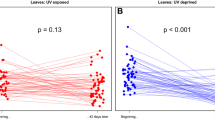Abstract
Solar UV light entering Lodgepole pine,Pinus contorta (Loud.) canopy was measured by radiometer and polysulphone film. It was found to be much attenuated among lower branches and nuclear polyhedrosis virus exposed there was significantly more infective to Pine beauty moth,Panolis flammea (D.+S.) than virus from upper branches.
Résumé
Les ultraviolets solaires atteignant la cime des Pins (Pinus contorta Loud.) ont été mesurés en utilisant la technique du radiomètre et du film de polysulphone. Il a été observé que la quantité d'ultraviolet était plus faible au niveau des branches basses, et que les virus de la polyhédrose nucléaire présents à cet endroit étaient significativement plus infectieux pour les papillons (Panolis flammea, D+S) que les virus présents sur les branches hautes.
Similar content being viewed by others
References
Abbott, W. S. — 1925. A method of computing the effectiveness of an insecticide. —J. Econ. Entomol., 18, 265–267.
Ballard, J. — 1987. Larval behaviour of the pine beauty moth. In: Population biology and control of the pine beauty moth — For. Comm. Bull. 67 (S. R. Leather, J. T. Stoakley &H. F. Evans, eds.). —HMSO, London, 31–36.
Bullock, H. R. — 1967. Persistence ofHeliothis nuclear-polyhedrosis virus on cotton foliage. —J. Invertebr. Pathol., 9, 434–436.
Carruthers, W. R., Cory, J. S. &Entwistle, P. F. — 1988. Recovery of pine beauty moth (Panolis flammea) nuclear polyhedrosis virus from pine foliage. —J. Invertebr. Pathol., 52, 27–32.
David, W. A. L. &Gardiner, B. O. C. — 1966. Persistence of a granulosis virus ofPieris brassicae on cabbage leaves. —J. Invertebr. Pathol., 8, 180–183.
David, W. A. L., Gardiner, B. O. C. &Woolner, M. — 1968. Effects of sunlight on a purified granulosis virus ofPieris brassicae applied to cabbage leaves. —J. Invertebr. Pathol., 11, 496–501.
Davis, A., Deane, G. H. W. &Diffey, B. L. — 1976. A possible dosimeter for ultraviolet radiation. —Nature, 261, 169–170.
Elgee, D. E. — 1975. Persistence of a virus of the white marked tussock moth on balsam fir foliage. —Can. For. Serv., Bi-monthly research notes 31, 33–34
Entwistle, P. F. &Evans, H. F. — 1987. Trials on the control ofPanolis flammea with a nuclear polyhedrosis virus. In: Population biology and control of pine beauty moth. For. Comm.Bull. 67 (S. R. Leather, J. T. Stoakley &H. F. Evans, eds.). —HMSO, London, 61–68.
Evans, H. F. &Entwistle, P. F. — 1982. Epizootiology of the nuclear polyhedrosis virus of European spruce sawfly with emphasis on persistence of virus outside the host. In: Microbial and Viral Pesticides (E. Kurstak, ed.). —Dekker, New York, USA, 449–462.
Finney, D. J. — 1971. Probit analysis, 3rd edition. —Cambridge University Press, Cambridge, UK.
Jones, K. A. &McKinley, D. J. — 1987. Persistence ofSpodoptera littoralis nuclear polyhedrosis virus on cotton in Egypt. In: Aspects of Applied Biology 14. —Assoc. of Appl. Biol., Wellesbourne, UK, 323–334.
Kaupp, W. J. — 1983. Persistence ofNeodiprion sertifer nuclear polyhedrosis virus onPinus contorta foliage. —Can. Entomol., 115, 869–873.
Killick, H. J. — 1987. Ultraviolet light andPanolis nuclear polyhedrosis virus; a non problem? In: Population biology and control of the Pine beauty moth. — For. Comm. Bull. 67 (S. R. Leather, J. T. Stoakley &H. F. Evans, eds.).—HMSO, London, 69–75.
Killick, H. J., Primarolo, A. A., McKenzie, R. M. &Forkner, A. C. — 1988. An inexpensive automatic recorder for biologically important solar UV. —Photochem. Photobiol., 48, 4, 555–557.
Matthews, G. A. — 1984. Pest management. —Longman, London & New York.
Olofsson, E. — 1988. Environmental persistence of the nuclear polyhedrosis virus of the European pine sawfly in relation to epizootics in Swedish pine forests. —J. Invertebr. Pathol., 52, 119–129.
Robinson, N. — 1966. Solar radiation. —Elsevier, Amsterdam, London & New York.
Schulze, R. K. &Grafe, K. — 1969. Consideration of sky UV radiation in the measurement of solar UV radiation. In: The biologic effects of ultraviolet radiation (F. Urbach ed.). —Pergamon Press, Oxford, UK, 359–373.
Smirnoff, W. A. — 1972. The effect of sunlight on the nuclear-polyhedrosis virus ofNeodiprion swainei with measurement of the solar energy received. —J. Invertebr. Pathol., 19, 179–188.
Yearian, W. C. &Young, S. Y. — 1982. Control of insect pests in agriculture. In: Microbial and Viral Pesticides (E. Kurstak, ed.). —Dekker, New York, USA, 387–424.
Author information
Authors and Affiliations
Additional information
S. J. Warden died April 1989
Rights and permissions
About this article
Cite this article
Killick, H.J., Warden, S.J. Ultraviolet penetration of pine trees and insect virus survival. Entomophaga 36, 87–94 (1991). https://doi.org/10.1007/BF02374639
Received:
Accepted:
Issue Date:
DOI: https://doi.org/10.1007/BF02374639




